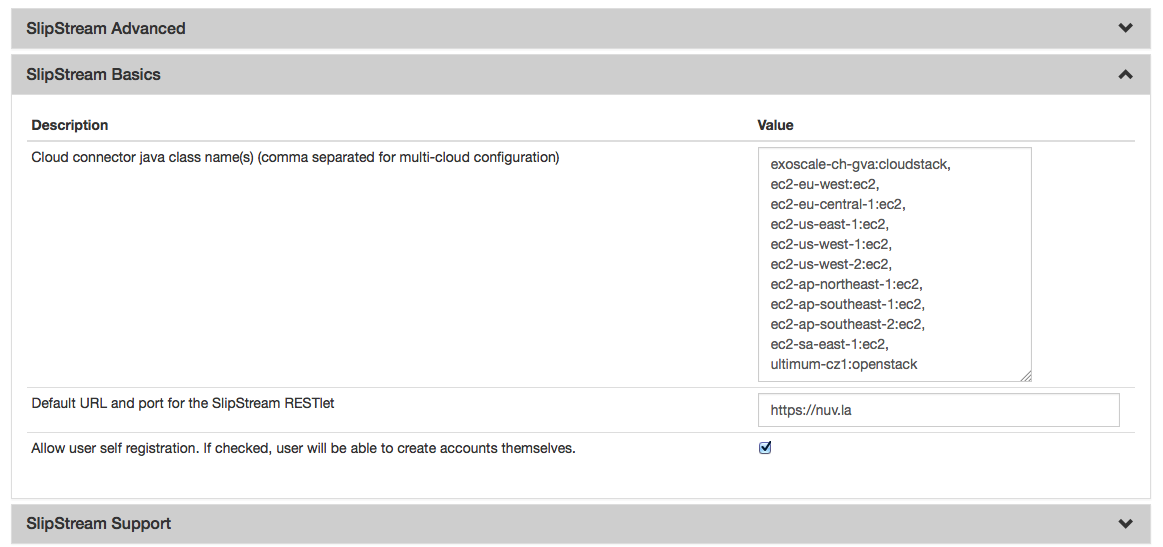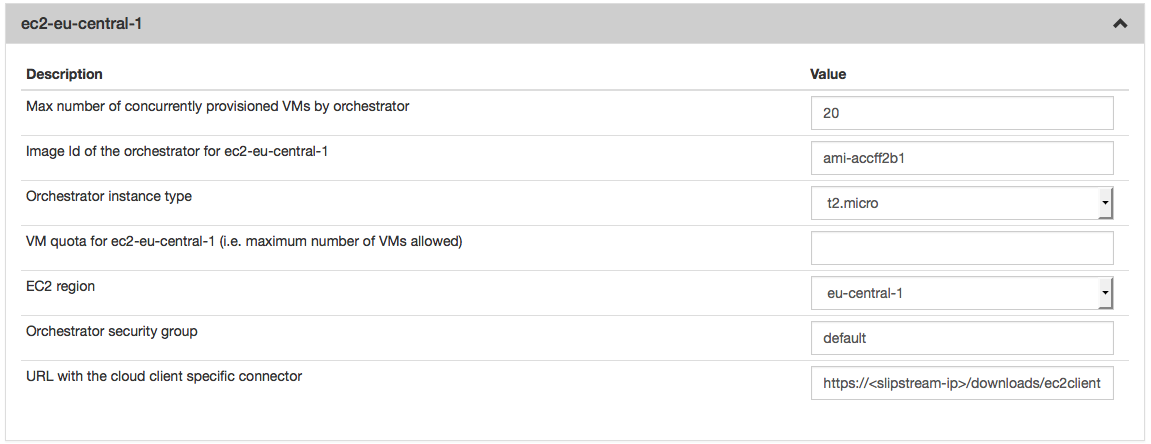Amazon EC2¶
License¶
This connector is distributed by SixSq under a commercial license and is available via various pricing plans. You can check it out with a free trail via our SaaS service. Feel free to contact the SlipStream Support team with any questions about how the SlipStream Amazon EC2 connector can be beneficial to you and your business.
Once you have purchased a new commercial connector, SixSq will provide you with a specific yum configuration.
Installation¶
Once your yum configuration is in place, you can install the connector executing the following command:
$ yum install slipstream-connector-ec2-enterprise
With the software installed, you need to restart the SlipStream service in order for it to take the new connector into account:
$ systemctl restart slipstream
Now we need to configure SlipStream to take advantage of the new connector.
Configuration¶
To allow users to take advantage of this connector, you must add one or more instances of this connector by either:
- Using the UI.
- Drop a configuration file and restart the service.
With the UI¶
Instanciate one or more instances of the connector¶
Once logged-in with a privileged user (e.g. super), open the configuration page by clicking on Configuration -> System at the top of the page. Then open the SlipStream Basics section and define a new instance of the connector with the following format:
<connector-instance-name>:<connector-name>
Here is an example:
amazon-ec2:ec2
You can also instantiate the connector several times (in compliance with your license) by comma separating the connector string. Here is an example:
ec2-eu-central-1:ec2, ec2-eu-west-1:ec2, ...
Here is a screenshot of the parameter to define:

SlipStream Configuation - Basics section
Don’t forget to save the configuration!
Now that the connector is loaded, you need to configure it.
Configure the connector instance¶
With the connector loaded in SlipStream, a new section in the configuration page will appear, allowing you to configure how the connector is to communicate with the IaaS cloud endpoint.

SlipStream Configuation - EC2 section
You can find a detailed description of each parameter as well as an
explaination of how to find the right value of them in the
`Parameters <#parameters>`__ paragraph below.
With a Configuration File¶
Please see Configuration Files for details about this method of configuration.
Here is an example, which will configure the EC2 connector to interact with the region eu-central-1:
> cat /etc/slipstream/connectors/ec2-eu-central-1.conf
cloud.connector.class = ec2-eu-central-1:ec2
ec2-eu-central-1.security.group = default
ec2-eu-central-1.update.clienturl = https://<slipstream-ip>/downloads/ec2client.tgz
ec2-eu-central-1.orchestrator.instance.type = t2.micro
ec2-eu-central-1.region = eu-central-1
ec2-eu-central-1.quota.vm =
ec2-eu-central-1.max.iaas.workers = 20
ec2-eu-central-1.orchestrator.imageid = ami-accff2b1
You can find a detailed description of each parameter as well as an
explaination of how to find the right value of them in the
`Parameters <#parameters>`__ paragraph below.
Parameters¶
EC2 region¶
The EC2 region defines where your EC2 instances will be deployed. Some parameters may be different between regions (e.g. image id: ami-…). If you want to use multiple regions concurrently, you will need to instantiate this connector multiple times.
Cloud Client Connector¶
This field corresponds to the URL where the Orchestrator will download
the tarball of the connector for the SlipStream Client. In a default
installation the URL will be
https://ip_or_hostname/downloads/ec2client.tgz where
ip_or_hostname corresponds to the IP or the hostname of your
SlipStream Server.
Orchestrator security group¶
The EC2 security group should allow TCP connexions from the Orchestrator
itself to the SlipStream server and to the EC2 API. The default security
group named default should normally work perfectly.
Image Id of the Orchestrator¶
The image id of the Orchestrator needs to match a Linux image with
wget and python installed. An Ubuntu 12.04 or 14.04 will do the
job perfectly (at the time or writing, for the region eu-west-1 the
image id is ami-a0dd3dd7). EC2 image ids start with ami-. You
can found them in the EC2 web interface.
Quota¶
The quota is a SlipStream feature which enables the SlipStream administrator to set a default quota for all users of a specified connector. You can also override this value for each user in the user profile. If this feature is disabled in the SlipStream Advanced section of this page, you can leave this field blank.
Configure Native Images for This Connector Instance¶
Now you need to update SlipStream native images to add the image id and some parameters specific to EC2.
This can be done via the UI or via configuration file. Documentation about how to do it via configuration file can be found here Unique Cloud Identifier Configuration Files.
Please go on a SlipStream base image (e.g. Ubuntu 12.04) and click on the Edit button. Add the image id for EC2 in the section named Cloud Image Identifiers and Image Hierarchy.
And then configure the default amount of CPU and RAM on the tab ec2 (or the name you gave your EC2 connector earlier) of the section Cloud Configuration.
User Credentials¶
Now that the connector is configured and the native images updated, inform your users that they need to configure their credentials for EC2 in their user profile to take advantage of your new connector.